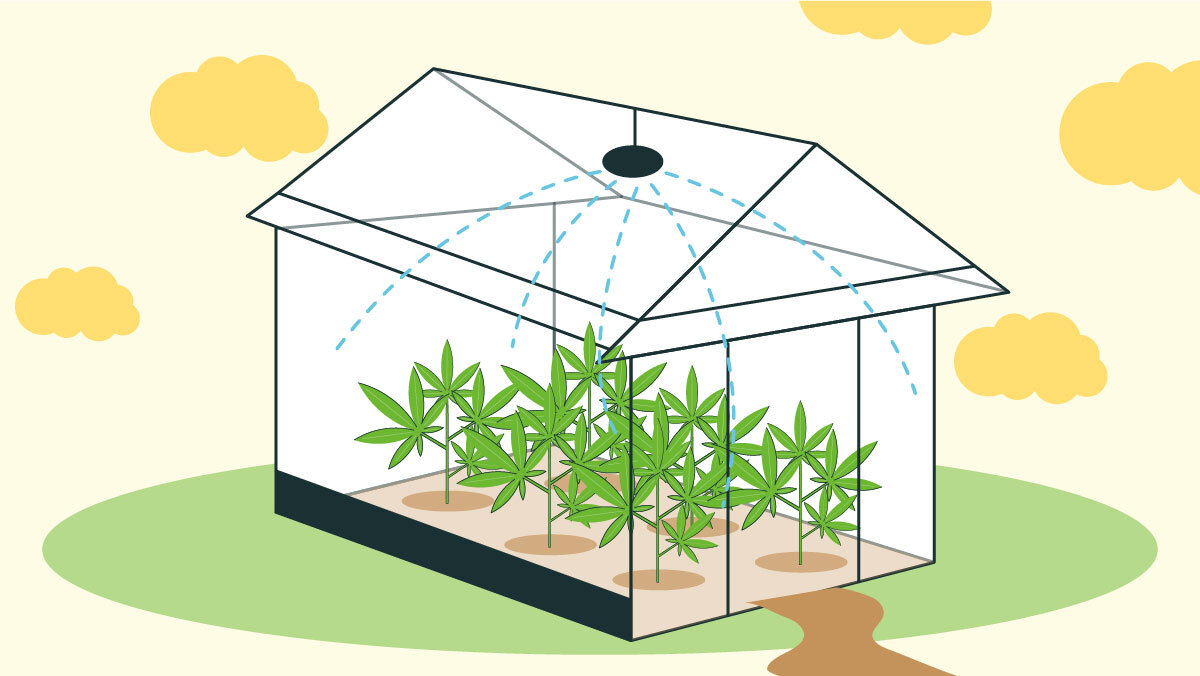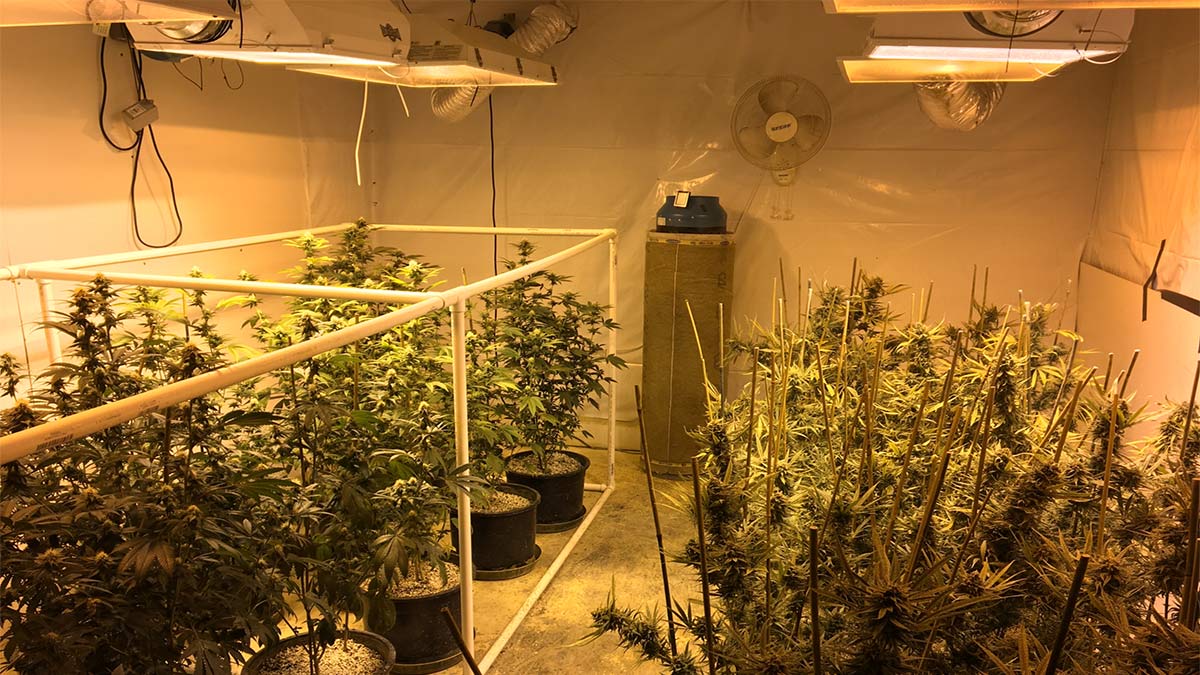How to Grow Weed In A Greenhouse?

Now that cannabis is legal in 37 states – and legal for recreational users in 18 – the number of people deciding to grow their own weed is increasing rapidly.
It’s not only an enjoyable hobby. It’s not only rewarding to harvest your crop. And it’s not just a way to save a significant amount of money over what they charge at dispensaries. (It’s also cheaper than buying from a dealer if you’re in one of the states where lawmakers are still living in the Dark Ages.)
Growing your own crop will allow you to enjoy the best-quality flower – but only if you do it the right way. You can grow marijuana almost anywhere. That doesn’t mean the conditions will be conducive, though.
You can set up plants in the outdoor garden you used in the past for tomatoes, or that unfinished area of your basement, or an unused closet. With the right amount of knowledge and care, you’ll probably wind up with a decent crop.
But the best way to grow weed is in an outdoor growhouse. Here’s how to do it.
Advantages Of Growing Weed In A Growhouse
A growhouse, as you’ve probably assumed, is just another word for the greenhouses that commercial gardeners use. And there’s a reason that they don’t simply plant all of their crops outdoors.
Just about all plants, including cannabis, can flourish when planted in the open air if they’re tended properly – and unless Mother Nature has other ideas.
A streak of bad weather (more common than ever in the global warming era) can damage or stunt your grow. Insects have free rein to invade outdoor plants, as do rabbits, birds, deer, and other uninvited visitors, not to mention jealous neighbors who may covet your crop. Plant diseases are more likely to run rampant in an uncontrolled environment. (And if you’re in a non-legal state or you’re growing more than is legally allowed, you can more easily hide your plants.)
Most of those reasons might argue for just growing your plants indoors. That’s not a bad idea if you have the space, all of the equipment necessary, and the money required for successful grow. Marijuana plants love natural sunlight, so you have to create the right artificial lighting for indoor growing. Watering indoors is more complicated. And it can be more difficult to optimize temperature and humidity in a small indoor space.
A growhouse solves just about all of those issues. It’s a larger but controlled space, lessening the difficulty of maintaining the right environment for the grow. Plants will receive natural warmth light, lessening the need for heaters and expensive lighting systems. Irrigation is easier, most pests and insects will be deterred from getting in, and the structure can be secured.
And in a temperature-controlled growhouse you can usually plant and harvest year-round. What’s not to like?
Setting up a growhouse isn’t simple and can’t be done in a day, but it’s definitely worth putting in the time and effort if you’re serious about growing your own weed.
Planning Your Growhouse

Creating a growhouse for your crop will take a good deal of planning. The first decision you’ll have to make is whether to build it yourself or purchase a premade greenhouse.
Building a Growhouse
DIYers may enjoy building their own green haven. It will be usually cheaper, too. Make sure that you have sufficient room for plants, storage, equipment – and possible expansion if you’re pleased with the grow but decide you need more plants. Your growhouse should face the sun and receive plenty of natural light each day; the more sunlight, the better the results will be.
If you don’t have money to burn, the greenhouse doesn’t have to be glassed-in. Plastic or fiberglass will work too, and they won’t break, either. When designing, be sure to plan for enough ventilation (there should be a plentiful number of vents at the top and the bottom of the structure) so heat and humidity won’t be trapped inside your growhouse. Also, make sure you don’t need a city or county permit to build.
Buying a Growhouse
If that’s too much work (and for most people, it will be), there’s an incredible assortment of pre-made greenhouses to choose from. A solid yet reasonably-priced free-standing growhouse may set you back anywhere from $750 to $1500, but it will come with vents and other accessories that will make the structure grow-ready.
Less-expensive options include greenhouses that attach to your house, and more rudimentary, less durable “polytunnels” (also called “hoop houses”) made from cheaper materials.
For all pre-made growhouses, the same space, ventilation, and sun exposure concerns should be considered before taking the plunge.
Getting Ready for the Grow
There are a number of other decisions to make before you can plant your crop.
Where to Plant
You can either plant your seeds in containers or if your growhouse doesn’t have a floor, right in the ground. Containers are more convenient because you can move the plants around (or take one outside if it gets infested), but putting them in the ground lets you leave the plants alone without tending for days, if necessary. You can also go the hydroponic route, but now we’re talking a lot more money.
Seeds and Soil
These could make the difference between a successful grow and a disappointing one. Buy organic soil with a pH between 5.6 and 6.5, and make sure it has high oxygen levels and drains well. If you have lots of space and plan to carefully control the light your plants receive, feminized seeds will grow the best. Otherwise, go for auto-flowering seeds whose plants grow smaller in size, aren’t as light-dependent, and produce massive yields. Jack Herer is a great choice for first-time greenhouse growers.
Other Equipment
If the plants won’t be getting 16-18 hours of sun during the vegetative stage and 12 hours during the flowering stage, you’ll need supplemental lighting (and perhaps blackout screens); this will be essential if you’re growing year-round. Exhaust fans (and perhaps humidifiers or dehumidifiers, depending on your climate) may be necessary to control temperature and humidity. And an automated watering system can greatly relieve the burden of day-to-day watering. Oh, and one more thing: make sure the growhouse can be locked.
Growing Weed In A Growhouse
You’re finally ready to plant and savor the moment when you can harvest your very own weed. Here are the things you’ll need to know to maximize the bounty.
- Start Your Seeds Early: The temperature in your growhouse will be warmer than the outdoor air, so you can plant earlier – although you may need supplemental heaters for nighttime. An early start will prolong the plants’ vegetative stage (which normally runs 4-12 weeks depending on the strain), so they can grow bigger and fuller and produce more buds.
- Pay Attention to Heat and Humidity: Even though you have vents (and possibly extra fans and humidifiers/dehumidifiers) in your growhouse, they won’t do much good unless they’re opened, closed, or turned on at the right times. Install thermometers and hygrometers, and check them regularly. Temperatures between 70-80° and humidity between 50-70% is ideal.
- Pay Attention to Light: If your plants aren’t getting enough (we’ve already mentioned the ideal amount of light), use blackout screens or supplemental lighting. It will make a huge difference.
- Pay Attention to the Plants: Inspect them regularly for signs of disease or insects; if you notice a problem early, carefully remove the affected leaves after bringing them outside to avoid contaminating the rest of the grow. Speaking of which, leave a good amount of space between your plants to prevent that from happening. Be sure to water, too; seedlings only need water once every 3-7 days, but in the vegetative and flowering stages the plants will need water once every 2-3 days. There are automatic watering systems you can install as well.
That should be enough to get you growing – and reaping the rewards of your own personal growhouse.
How To Grow Weed In A Growhouse? FAQ
Q: Can you keep using the growhouse in the winter?
A: As long as outside temperatures don’t go below zero, you should be OK as long as you install sufficient artificial light and supplemental heating.
Q: How much ventilation does a growhouse need?
A: A lot. You’ll need vents at the top (for outgoing air) and at the bottom (for incoming air). One rule of thumb is that the combined square footage of the vents should be at least 20% of the square footage of the growhouse.
Q: What do I do about the smell?
A: Unfortunately, fans with carbon filters won’t do enough heavy lifting to get rid of the telltale cannabis odor in a decent-sized growhouse. An in-line ozone generator (which works in conjunction with a fan) will do the job, but make sure never to use it if the fan is also running. Otherwise, the high levels of ozone could be hazardous.